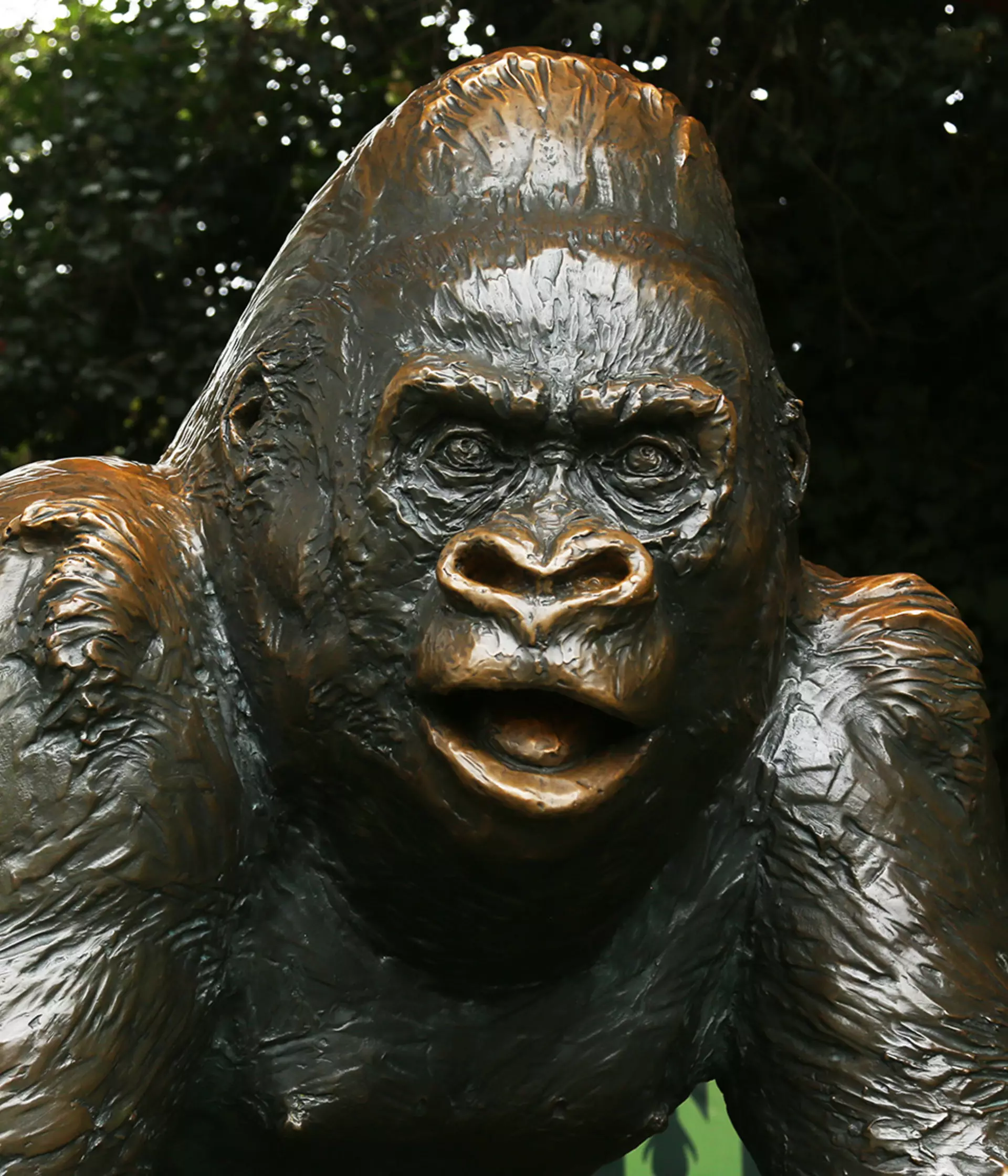Wildlife sculptures and art
Our Zoo is filled with hidden treasures which tell stories of our two-hundred year history. The art in our Zoo is unlike anywhere else in London, celebrating our trailblazing scientists and iconic animals.
As visitors enter the they encounter a bronze sculpture of one of our most famous animals – Guy the gorilla. The sculpture itself is also very popular, make sure you stop and say ‘hello’ when you visit. This bronze, from 1982, is by William Timym, 1902-1990. Guy the gorilla, 1946-1978, was an immensely popular animal at the Zoo, possibly the most popular ever? Although Guy was large, this sculpture is larger than life size. He has been moved to various locations around the Zoo but he has been in his present location, greeting visitors since 2012.
Animal statues
A few smaller bronzes by William Timym can be found in ZSL Library & Archives and a large painting of Guy the gorilla.
William Timym was also sculptor of a bronze head of a male lion found in Land of the Lions. This sculpture was presented to ZSL in 1976 when the previous lion exhibit was first opened, the Lion Terraces. If you are visiting do rub his nose for good luck.
Another lion's head can be found in Land of the Lions, this is thought to date from 1875 and was in the Old Lion House built in 1875-77. It is now opposite the entrance to the London Zoo Lodges where guests can stay book to stay overnight.
Winnie the Pooh statue
Another famous former inhabitant was Winnie the bear who helped to inspire A.A. Milne’s ‘Pooh bear’. We have two sculptures of Winnie at the Zoo.
Winnie, c1914-1934, a young black bear, was purchased by Lieutenant Harry Colebourn. She was named Winnie after the city of Winnipeg, Lt. Colebourn’s home. She was brought to England with him, becoming the mascot of his regiment, the Second Canadian Infantry Brigade. When going to fight in France, Lt. Colebourn left Winnie at London Zoo for safekeeping. He visited when he could but at the end of the First World War he decided to present her to ZSL. A bronze of Winnie with Lt. Colebourn can be seen next to ZSL’s War Memorial just outside Butterfly Paradise near the pelicans. Bill Epp is the sculptor of the bronze, it was presented in 1995 by the ‘people of Manitoba through their Government’.
Tim Hunkin clock
Winnie’s name was immortalised by A.A. Milne in his ‘Winnie-the-Pooh’ books. A.A. Milne and his son, Christopher Robin, were frequent visitors to the Zoo.
A sculpture of Winnie can be found in Animal Adventure this is a bronze by Lorne McKean. It was unveiled by Christopher Robin Milne in 1981.
An amazing automaton is found outside the entrance to the Blackburn Pavilion. It is a clock designed by Tim Hunkin, engineer, artist, cartoonist and writer. Make sure to see the clock on the hour or half hour when it springs to life, beginning with clanking noises before people and birds begin to move. Keep an eye on the letters spelling out ‘Blackburn Pavilion’ on the roof of the building as something appearing there can be easily missed.
Beetle art
Wendy Taylor is the creator of a bronze sculpture of two dung beetles in the act of rolling a ball of dung, it is outside Tiny Giants. The beetles and ball of dung are much larger than life-size! Another Wendy Taylor sculpture is located between the Wildlife Garden and the entrance gate to Land of the Lions, a large sundial in the form of an aluminium globe.
Obaysch the hippo
Our model Obaysch commemorates the first hippo seen alive in Europe since the Imperial Exhibitions in the Arenas of Ancient Rome. This model even featured in a museum exhibition along with his photograph in the Frederick York Album and a drawing of him by Joseph Wolf.
The history of Obaysch's capture is recorded by Samuel Shepheard, the founder of Shepheard's Hotel, Cairo, who wrote on November 14th, 1849:- "In the spring of the year, Inshallah!, your London visitors will be gratified with a sight of one of our river monsters - the Hippopotamus. Our consul here, the honourable Mr Murray, having expressed a wish to have one sent to England, where such a thing had never yet been seen, His Highness ordered off a Captain with a troop of twenty men to proceed up the interior of Africa to follow the course of the white river and not to return without one. After having been five months away they have returned and brought a very fine specimen 5 or 6 months old. He is yet a suckling and drinks 80 pints of milk at a meal and, unwieldy as he is, plays about with the keeper like a great fat pet pig with a square head. The Pasha has presented him to Mr Murray."
The young hippopotamus was transported to London and in 1850 the Hippo House in the London Zoo was built to accommodate Obaysch, which lived there until its death in 1878. This model, commissioned by Samuel Shepheard, was donated to us in 1946 by his grandson, the Reverend G.S. Bird, FZS.
Tiger Territory contains a streak of tiger sculptures by a variety of sculptors. A 'streak' is the collective noun for tigers, useful to know in quizzes!
Many more sculptures can be found at London Zoo, so do look out for them as you explore. Further details of these sculptures and their sculptors can be found in ZSL Library and Archives online catalogue. To search for these and other art works click ‘Search Artworks’ on the left-hand sidebar and enter some details in the search box to discover more. The catalogue also includes details of other sculptures at ZSL London Zoo as well as other works of art in ZSL’s collections. Please do enjoy these works of art and be inspired!
